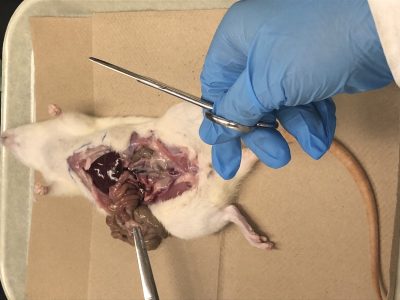INTRODUCTION
A uterine contraction is a muscle contraction of the uterine smooth muscle, it plays various roles in reproductive functions such as gestation and parturition (Aguilar and Mitchell, 2010, abstract). The uterine smooth muscle contraction is regulated by the autonomic nervous system, contraction is produced by activation of parasympathetic nerves via muscarinic receptors (Sato et al., 1996, abstract). The parasympathetic nervous system uses acetylcholine (ACh) as its major neurotransmitter. In the parasympathetic nervous system, the postganglionic cell releases ACh to transfer the signal to the target organ has muscarinic ACh receptors, then the muscle contract when the receptors receive the signal and pass the stimulations (Heilbronn and Bartfai, 1978, p.171), then the smooth muscle contracts. Atropine blocks the action of ACh at muscarinic receptors, and curare is an antagonist of nicotinic ACh receptors (Edman and Schild, 1962, p.424). When the antagonist blocks the ACh receptors, the receptors cannot receive the signal, therefore the muscle cannot contract.
This experiment is focusing on investigating the rat uterus contraction that controlled by parasympathetic nervous system. The questions under investigation are: what are the influences of the parasympathetic nervous system on uterine contractions and which receptor (nicotinic or muscarinic) on the uterus smooth muscle cells mediates the parasympathetic response (contraction)? The hypothesis for this question is the uterine will contract since it will be stimulated by ACh, which is the parasympathetic neurotransmitter. Besides, muscarinic receptor mediates the effect of ACh on the uterine contraction since atropine will bind to muscarinic receptor on the target organ of parasympathetic nervous system, uterus will not contract.
The result was predicted to be when ACh added to the bath, the muscle will have significantly contraction than before adding the drug, and when atropine was added as a competitive antagonist of the action of ACh bind to muscarinic receptor in parasympathetic nervous system, the uterus will not contract.
In this experiment, the fresh dissected uterus of mice (Mus musculus) will be anchored in the drug bath, the uterine contraction will be recorded by the isotonic transducer connected to PASCO capstone. To test the hypothesis, ACh will be used to exam the effect of parasympathetic nervous system on uterus, and atropine or curare will be applied as the antagonist of ACh bind to nicotinic or muscarinic receptor.
Dissection 